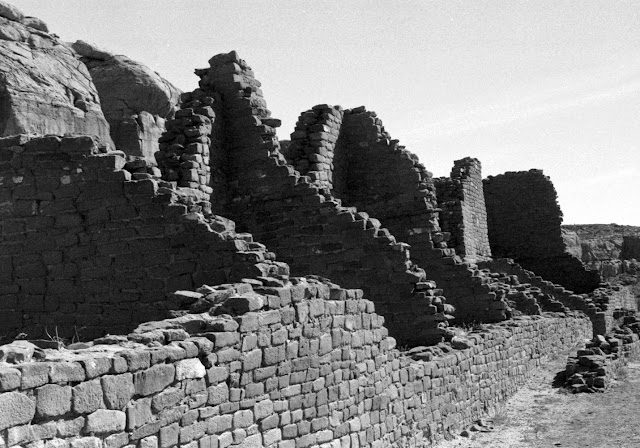I finished a roll of color on our walk through the great houses of Chetro Ketl and Pueblo Bonito. Then we got back in the car and drove to the end of the loop road to visit the Kin Kletso and Pueblo del Arroyo sites. For that part of our tour I shot Fomapan 200 in my Leica IIIa with the Elmar 3.5/50.
While there are similarities in the layouts, there is an obvious difference in the architectural styles of these two great houses from the larger ones to the east. The source of the stone walls at these western sites was the talus slope rubble at the base of the great cliffs, while the two large sites to the east used a lot of thin, tablet-like masonry mined from higher up in the cliffs.
Archaeologists in the past sorted the dozen Chaco sites into three different phases, but I think subsequent dendrochronological analysis determined that the building styles were actually contemporaneous. In addition to the stonework, all of the sites made extensive use of wood for door and window lintels, floors, ceilings and platforms.
While I was walking through the Pueblo del Arroyo site a couple passed by and I heard the man comment that it seemed unlikely the many wood beams in evidence were original to the site given the thousand years since the great house was built. While it is true that there has been some reconstruction and stabilization, there are still a lot of wooden elements that have been preserved by burial in a dry climate. In fact, thousands of timbers have been cataloged and examined to determine species, age and origins.
Near Pueblo del Arroyo is a stone stairway which leads up over the cliffs to the beginning of one of the ancient roads which radiate out from Chaco Canyon. In Great Pueblo Architecture of Chaco Canyon, Stephen H. Lekson mentions that one important use of the roads was the transportation of timber from forty or more kilometers from the Chaco sites. In browsing around on the net for further information about those roadways I came across the interesting thesis that the big logs were probably rolled down the roads rather than being carried as is often asserted. That certainly fits with the width and smoothness of the roads and the fact that the Ancestral Puebloans had no beasts of burden or wheeled vehicles to assist with transport.
Time and the elements have sculpted the walls of the great houses into shapes which invite photographic interpretation while also obscuring the original forms and surface appearances of the structures. I'm thinking it would be rewarding to print out the pdf of Lekson's book and take it along on the next trip to Chaco to help in achieving a more coherent understanding of this extraordinary place.
Some Illustrations from Lekson (National Park Service, Dept. of the Interior - 1984):







The stonework is fascinating. The stones look like they were smoothed and shaped, but the builders did not try to make them uniform size. But they were positioned to have minimal gaps. What a terrific effort a millennium (or more) ago.
ReplyDeleteThe little Leica is behaving well!
It is pretty astounding that it was all built with stone tools, muscle power and patience.
ReplyDelete